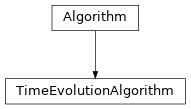TimeEvolutionAlgorithm¶
full name: tenpy.algorithms.algorithm.TimeEvolutionAlgorithm
parent module:
tenpy.algorithms.algorithmtype: class
Inheritance Diagram

Methods
|
|
Return necessary data to resume a |
|
Resume a run that was interrupted. |
|
Perform a real-time evolution of |
Class Attributes and Properties
whether the algorithm supports time-dependent H |
|
|
- class tenpy.algorithms.algorithm.TimeEvolutionAlgorithm(psi, model, options, **kwargs)[source]¶
Bases:
tenpy.algorithms.algorithm.AlgorithmCommon interface for (real) time evolution algorithms.
Parameters are the same as for
Algorithm.Options
- config TimeEvolutionAlgorithm¶
option summary Minimal time step by which to evolve.
Number of time steps `dt` to evolve by in :meth:`run`. [...]
Initial value for :attr:`evolved_time`.
trunc_params (from Algorithm) in Algorithm
Truncation parameters as described in :cfg:config:`truncation`.
- option start_time: float¶
Initial value for
evolved_time.
- option dt: float¶
Minimal time step by which to evolve.
- evolved_time¶
Indicating how long psi has been evolved,
psi = exp(-i * evolved_time * H) psi(t=0). Not that the real-part of t is increasing for a real-time evolution, while the imaginary-part of t is decreasing for a imaginary time evolution.
- time_dependent_H = False¶
whether the algorithm supports time-dependent H
- get_resume_data(sequential_simulations=False)[source]¶
Return necessary data to resume a
run()interrupted at a checkpoint.At a
checkpoint, you can savepsi,modelandoptionsalong with the data returned by this function. When the simulation aborts, you can resume it using this saved data with:eng = AlgorithmClass(psi, model, options, resume_data=resume_data) eng.resume_run()
An algorithm which doesn’t support this should override resume_run to raise an Error.
- Parameters
sequential_simulations (bool) – If True, return only the data for re-initializing a sequential simulation run, where we “adiabatically” follow the evolution of a ground state (for variational algorithms), or do series of quenches (for time evolution algorithms); see
run_seq_simulations().- Returns
resume_data – Dictionary with necessary data (apart from copies of psi, model, options) that allows to continue the simulation from where we are now. It might contain an explicit copy of psi.
- Return type
- resume_run()[source]¶
Resume a run that was interrupted.
In case we saved an intermediate result at a
checkpoint, this function allows to resume therun()of the algorithm (after re-initialization with the resume_data). Since most algorithms just have a while loop with break conditions, the default behaviour implemented here is to just callrun().